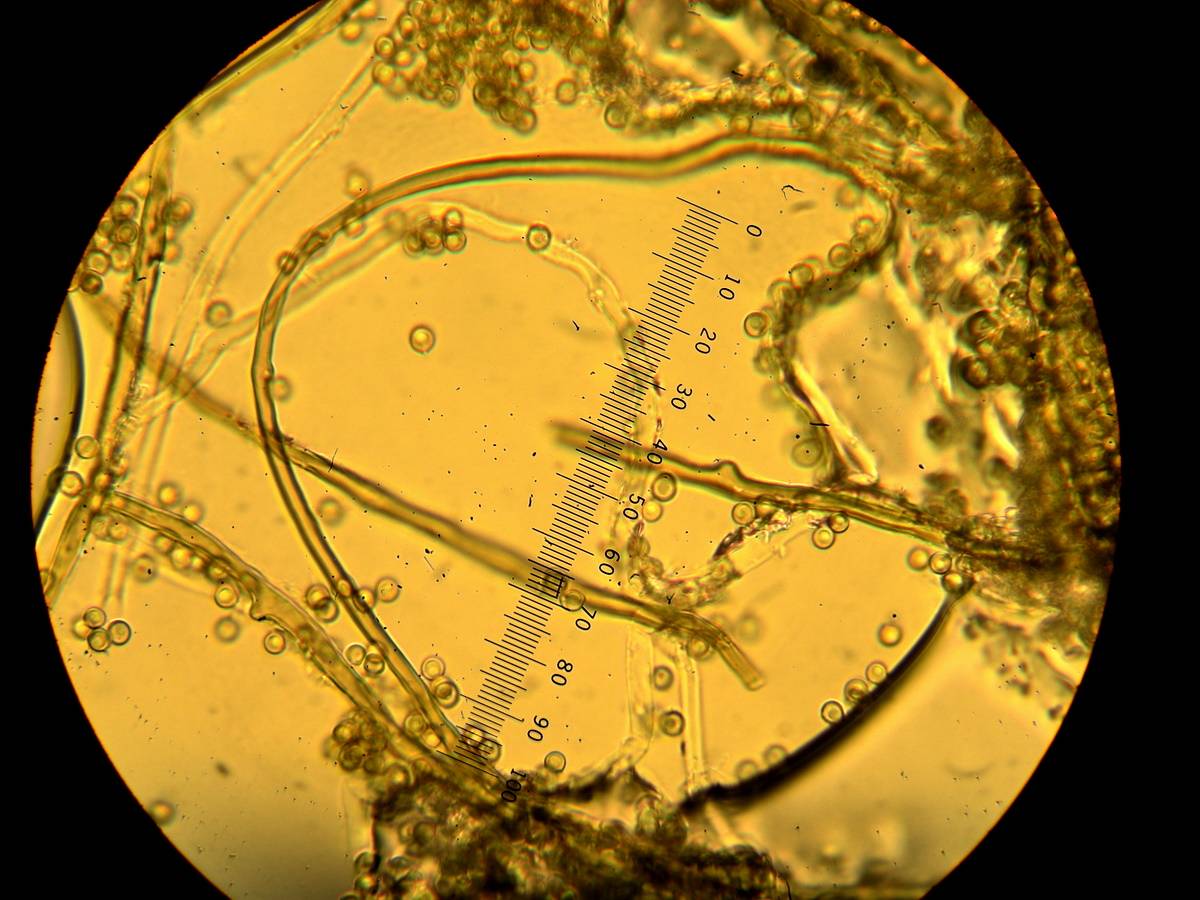|
Trichia Decipiens
''Trichia decipiens'' is a worldwide widespread slime mould species from the order Trichiida. Characteristics The plasmodium is white, becoming pink to red at maturity. The small- to large-group-forming fruiting bodies are shiny olive to yellow-olive or brown, and bear mainly stalked, rarely sessile sporangia. These are conical to peak-shaped and are up to 3 mm high and 0.6 to 0.8 (rarely up to 1.3) mm wide. The shiny, membraneous hypothallus is wide, and pale to brown in colour. The cylindrical stem is wrinkled, dark brown at the base and becoming gradually lighter toward the top, and is filled with up to 1 mm-long, spore-like bodies. The solid or membranous peridium is yellow, often transparent on thin areas, thickened and deeper beneath, surviving as an initially shallow calyculus. The capillitium from the mass is olive to olive-yellow and is composed of non-overgrown, simple or branched, deeply olive-yellow, 5 to 6 μm thick elaters, which stand i ... [...More Info...] [...Related Items...] OR: [Wikipedia] [Google] [Baidu] |
Christiaan Hendrik Persoon
Christiaan Hendrik Persoon (31 December 1761 – 16 November 1836) was a Cape Colony mycologist who is recognized as one of the founders of mycology, mycological Taxonomy (biology), taxonomy. Early life Persoon was born in Cape Colony at the Cape of Good Hope, the third child of an immigrant Pomeranian father, Christiaan Daniel Persoon, and Netherlands, Dutch mother, Wilhelmina Elizabeth Groenwald. His mother died soon after he was born. In 1775, at the age of thirteen, he was sent to Europe for his education. His father died a year later in 1776. Education Initially a student of theology at University of Halle-Wittenberg, Halle, Persoon switched his studies to medicine, which he pursued in Leiden and then Göttingen. He received a doctorate from the German National Academy of Sciences Leopoldina, Deutsche Akademie der Naturforscher in Erlangen 1799. Later years He moved to Paris by 1803, where he spent the rest of his life, renting the upper floor of a house in a poor ... [...More Info...] [...Related Items...] OR: [Wikipedia] [Google] [Baidu] |
Capillitium
Capillitium (pl. capillitia) is a mass of sterile fibers within a fruit body interspersed among spores. It is found in Mycetozoa Mycetozoa is a polyphyletic grouping of slime molds. It was originally thought to be a monophyletic clade, but in 2010 it was discovered that protostelia are a polyphyletic group within Conosa. Classification It can be divided into dictyoste ... (slime molds) and gasteroid fungi of the fungal subdivision Agaricomycotina. In the fungi, the form of the capillitia, including shape, size, branching patterns, presence or absence of slits or pores, thickness of the walls, and color, are features that can be used to identify certain species or genera. References {{Reflist, refs= {{cite book , title=Poisonous Mushrooms of the northern United States and Canada , vauthors=Ammirati J, Traquair JA, Horgen PA , year=1985 , publisher=Fitzhenry & Whiteside in cooperation with Agriculture Canada , location=Markham, Ontario , isbn=978-0889029774 , page=30, 376 ... [...More Info...] [...Related Items...] OR: [Wikipedia] [Google] [Baidu] |
Thomas Huston Macbride
Thomas Huston Macbride (July 31, 1848 – March 27, 1934) was the tenth president of the University of Iowa, serving from 1914 to 1916. Macbride was a naturalist and botanist, Macbride Hall at the University of Iowa is named for him. He often collaborated with Samuel Calvin. He was the 75th member of the Acacia chapter at the University of Iowa. In 1909, botanist Fred Jay Seaver published ''Macbridella'' a genus of (in fungi family of Melanommataceae), and named in his honour. Then in 1934, botanist Henry Clark Gilbert in the journal of Univ. Iowa Stud. Nat. Hist. circumscribed the genus of Amoebozoa Amoebozoa is a major Taxonomy (biology), taxonomic group containing about 2,400 described species of Amoeba, amoeboid protists, often possessing blunt, fingerlike, Pseudopod#Morphology, lobose pseudopods and tubular mitochondrial cristae. In trad ... (from the family Stemonitidaceae), '' Macbrideola''. He noted 'This new genus is named in honor of Dr. Thomas H. Macbride, ... [...More Info...] [...Related Items...] OR: [Wikipedia] [Google] [Baidu] |
Chemnitz
Chemnitz (; from 1953 to 1990: Karl-Marx-Stadt (); ; ) is the third-largest city in the Germany, German States of Germany, state of Saxony after Leipzig and Dresden, and the fourth-largest city in the area of former East Germany after (East Berlin, East) Berlin, Leipzig, and Dresden. The city lies in the middle of a string of cities sitting in the densely populated northern Ore Mountain Foreland, foreland of the Elster Mountains, Elster and Ore Mountains, stretching from Plauen in the southwest via Zwickau, Chemnitz and Freiberg to Dresden in the northeast, and is part of the Central German Metropolitan Region. Located in the Ore Mountain Basin, the city is surrounded by the Ore Mountains to the south and the Central Saxon Hills, Central Saxon Hill Country to the north. The city stands on the Chemnitz River, which is formed through the confluence of the rivers Zwönitz (river), Zwönitz and Würschnitz in the borough of Altchemnitz. The name of the city as well as the names o ... [...More Info...] [...Related Items...] OR: [Wikipedia] [Google] [Baidu] |
Stemonitis Typhina
''Stemonitis'' is a distinctive genus of slime moulds found throughout the world (except Antarctica). They are characterised by the tall brown sporangia, supported on slender stalks, which grow in clusters on rotting wood. The genus was first described by German botanist Johann Gottlieb Gleditsch in 1753. A 2014 estimate suggests that there are 18 species in the genus. Identification within the genus is difficult, and can only be performed with confidence using a microscope or by DNA sequencing. A fossil specimen (in Burmese amber) is known from the mid-Cretaceous (99 ma). Species The following species are accepted by ''Species Fungorum'': *''Stemonitis axifera'' (Bull.) T.Macbr. (1889) *''Stemonitis farrensis'' T. N. Lakh. & Mukerji (1977) *''Stemonitis ferruginea'' Ehrenb. (1818) *''Stemonitis flavogenita'' E. Jahn (1904) *''Stemonitis foliicola'' Ing (1967) *''Stemonitis fusca'' Roth (1787) *''Stemonitis graciliformis'' Nann.-Bremek., Mukerji & Pasricha (1984) *''Stemonitis h ... [...More Info...] [...Related Items...] OR: [Wikipedia] [Google] [Baidu] |
Lycogala Epidendrum
''Lycogala epidendrum'', commonly known as wolf's milk or groening's slime, is a cosmopolitan species of myxogastrid amoeba which is often mistaken for a fungus. The aethalia, or fruiting bodies, occur either scattered or in groups on damp rotten wood, especially on large logs, from June to November. These aethalia are small, pink to brown cushion-like blobs. They may ooze a pink "paste" if the outer wall is broken before maturity. When mature, the colour tends to become more brownish. When not fruiting, single celled individuals move about as very small, red amoeba-like organisms called plasmodia, masses of protoplasm that engulf bacteria, as well as fungal and plant spores, protozoa, and particles of non-living organic matter through phagocytosis (see slime mould for more information). Description During the plasmodial stage, individuals are reddish in colour, but these are almost never seen. When conditions change, the individuals aggregate by means of chemical signalling ... [...More Info...] [...Related Items...] OR: [Wikipedia] [Google] [Baidu] |
Cribraria
''Cribraria'' is a genus of slime molds from the group of Myxogastria. It comprises about 30 species, some of which are extremely difficult to distinguish. Features The fruiting bodies are usually pedunculated sporangia, a calyculus may be present or absent. The delicate peridium is reduced to a structure of vertical, thickened threads that are interconnected by extremely fine, translucent transverse threads.Michael J. Dykstra, Harold W. Keller: ''Mycetozoa'' In: ''Illustrated Guide to the Protozoa'', John J. Lee, Gordon F. Leedale, Phyllis Bradbury, Society of Protozoologists, 2nd edition, volume 2, pp. 952-981 In some cases, however, the peridium may also appear like a net, as in '' Cribraria '' - species. Mostly dark, clearly visible dictydine granules are found especially close to the ribs of the peridia, the calyculus and the spores.Marie L. Farr: ''Myxomycetes'', New York Botanical Garden, 1976, pp. 88-89 Distribution The genus is distributed worldwide, about two-thi ... [...More Info...] [...Related Items...] OR: [Wikipedia] [Google] [Baidu] |
Arcyria
''Arcyria'' is a genus of Amoebozoa in the family Arcyriaceae.Cooke, M.C. (1877) Contributions to Mycologica Britannica. The Myxomycetes of Great Britain: 69 (1877)Mycobank: Acyriaceae Accessed 16 June 2019. It includes the species '' Arcyria ferruginea'' . Species *'' Arcyria affinis'' *'' Arcyria afroalpina'' *'' |
Trichia
''Trichia'' is a genus (biology), genus of slime molds in the family (biology), family Trichiaceae. , there are 34 species in the genus. Species *''Trichia affinis'' *''Trichia agaves'' *''Trichia alpina'' *''Trichia antartica'' *''Trichia botrytis'' *''Trichia brevicapillata'' *''Trichia brimsiorum'' *''Trichia brunnea'' *''Trichia conglobata'' *''Trichia contorta'' *''Trichia crateriformis'' *''Trichia crenulata'' *''Trichia decipiens'' *''Trichia elaterensis'' *''Trichia erecta'' *''Trichia favoginea'' *''Trichia fimicola'' *''Trichia flavicoma'' *''Trichia heteroelaterum'' *''Trichia huizhongii'' *''Trichia lutescens'' *''Trichia macbridei'' *''Trichia microspora'' *''Trichia mirabilis'' *''Trichia munda'' *''Trichia nodosa'' *''Trichia papillata'' *''Trichia persimilis'' *''Trichia scabra'' *''Trichia sordida'' *''Trichia subfusca'' *''Trichia subretispora'' *''Trichia varia'' *''Trichia verrucosa'' References Myxogastria Myxogastria genera {{Amoebozoa-stub ... [...More Info...] [...Related Items...] OR: [Wikipedia] [Google] [Baidu] |
Broadleaf Tree
A broad-leaved, broad-leaf, or broadleaf tree is any tree within the diverse botanical group of angiosperms that has flat leaves and produces seeds inside of fruits. It is one of two general types of trees, the other being a conifer, a tree with needle-like or scale-like leaves and seeds borne in woody cones. Broad-leaved trees are sometimes known as hardwoods. Most deciduous trees are broad-leavedLee, S. and A. RafloTrees and Water. Virginia Water Resources Research Center. Virginia Tech. but some are coniferous, like larches. U.S. Department of Agriculture Tree types Gallery [...More Info...] [...Related Items...] OR: [Wikipedia] [Google] [Baidu] |
Conifers
Conifers () are a group of cone-bearing seed plants, a subset of gymnosperms. Scientifically, they make up the division Pinophyta (), also known as Coniferophyta () or Coniferae. The division contains a single extant class, Pinopsida. All extant conifers are perennial woody plants with secondary growth. The majority are trees, though a few are shrubs. Examples include cedars, Douglas-firs, cypresses, firs, junipers, kauri, larches, pines, hemlocks, redwoods, spruces, and yews.Campbell, Reece, "Phylum Coniferophyta". ''Biology''. 7th ed. 2005. Print. p. 595. As of 2002, Pinophyta contained seven families, 60 to 65 genera, and more than 600 living species. Although the total number of species is relatively small, conifers are ecologically important. They are the dominant plants over large areas of land, most notably the taiga of the Northern Hemisphere, but also in similar cool climates in mountains further south. Boreal conifers have many wintertime adaptations. The ... [...More Info...] [...Related Items...] OR: [Wikipedia] [Google] [Baidu] |
Elater
An elater is a cell (or structure attached to a cell) that is hygroscopic, and therefore will change shape in response to changes in moisture in the environment. Elaters come in a variety of forms, but are always associated with plant spores. In many plants that do not have seeds, they function in dispersing the spores to a new location. Mosses do not have elaters, but peristomes which change shape with changes in humidity or moisture to allow for a gradual release of spores. Horsetail elaters In the horsetails, elaters are four ribbon-like appendages attached to the spores. These appendages develop from an outer spiral layer of the spore wall. At maturity, the four strips peel away from the inner wall, except at a single point on the spore where all four strips are attached. Under moist conditions, the elaters curl tightly around the spore. The wet spores tend to stick to each other and to nearby surfaces because of surface tension. When conditions are dry, the spores no lon ... [...More Info...] [...Related Items...] OR: [Wikipedia] [Google] [Baidu] |



